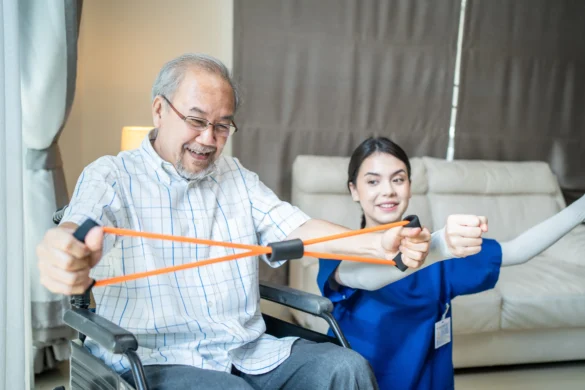As seniors age, they may find it increasingly difficult to participate in ADL (activities of daily living). Limited mobility and chronic conditions may prevent them from successfully completing everyday tasks, negatively impacting independent living. Occupational therapy (OT) can help.
OT aims to determine the tasks seniors do most inside and outside the home and the issues impeding their progress. The therapist then determines exercises and tools that can increase mobility and provide support. With the right approach, older adults who engage in these programs achieve the comfort of aging in place while reducing stress on family caregivers.
What is Involved in Occupational Therapy?
Occupational therapy is a multi-step process, as follows:
- Assessment: The therapist will begin by assessing the aged individual’s health conditions that could impact mobility. They will also determine which mental and physical tasks are most necessary for senior living.
- Develop an Individualized Treatment Plan: The next step involves developing a care plan that meets the person’s needs. The therapist may recommend an exercise regimen, retraining muscles so the elderly individual regains mobility, or installing assistive equipment like grab bars inside the home. Cognitive approaches may also be included, which can be helpful for patients with dementia.
- Assistance with Treatment: The therapist will continue seeing the patient, assisting them with exercise training, or ensuring they can use home equipment. Care can be short-term or ongoing.
Although OT is common in geriatrics, it can also be used in recovery for individuals of all ages and abilities.
What are the Benefits of Occupational Therapy?
Seniors who receive occupational therapy often experience the following benefits:
- Live More Independently: As per an AARP study, 75% of seniors prefer to age in place. Seniors who receive occupational therapy live more independently and can often stay at home rather than moving to an assisted living facility.
- Less Stress for Family Caregivers: This type of geriatric care allows individuals to complete more tasks themselves, so they don’t have to rely as much on family caregivers. Relatives experience less stress and can focus more on their personal and professional lives.
- Better Quality of Life: Older adults typically experience higher levels of self-confidence after undergoing OT. Additionally, the therapy helps them become stronger mentally and physically, supporting a healthier lifestyle.
Who are Occupational Therapists and Where Do They Work?
Occupational therapists are typically board-certified professionals, such as licensed therapists and therapy assistants. They can travel to a person’s home or provide care in a clinic or hospital setting.
Caring Family Offers Occupational Therapy and Other In-Home Services
Caring Family is a provider you can trust. We work with families, physicians, and individuals to determine a patient-centered plan suited to our clients’ physical and mental goals. Our compassionate providers offer therapy, respite care, and home care tailored to improve your loved one’s quality of life.
Contact us to learn more about how we can help your family thrive.
FAQs
What are the areas that an occupational therapist might assist a senior with?
An occupational therapist may help an older adult complete daily tasks like eating, bathing, meal prep, and self-care more safely and efficiently.
What is the difference between an OT and OTA?
An OT, or occupational therapist, is a licensed professional with a master’s or doctoral degree who evaluates patients and creates treatment plans. An OTA, or occupational therapist assistant, has an associate’s degree and works under an OT to implement plans and generate progress reports.
What is the future of occupational therapy?
The occupational therapy industry is predicted to thrive due to increased demand. Delivery methods will become more technology-based, involving AI, wearables, and virtual and augmented reality. The goal is to make treatments more personalized and effective.




